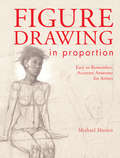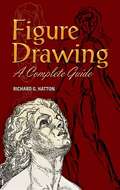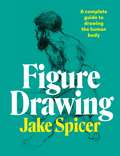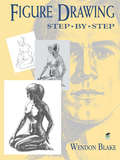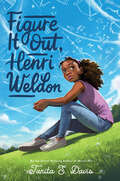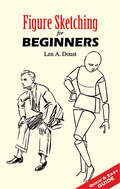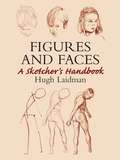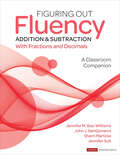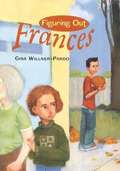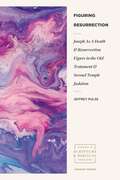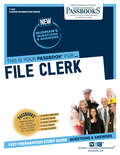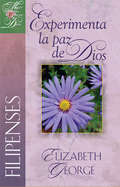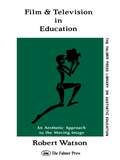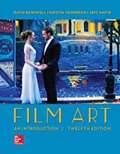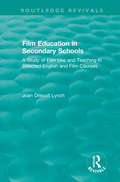- Table View
- List View
Figure Drawing in Proportion: Easy to Remember, Accurate Anatomy for Artists
by Michael MassenAn intuitive approach for figure artists to get proportions right. Traditional methods of measuring body proportions rely on the abstract memorization of convoluted fractions or multiples of the human head. But artists shouldn't have to be mathematicians. Figure Drawing in Proportion introduces a better, more intuitive, less intimidating way to get proportions right. It starts with the revelation that--despite the wonderful variety of bodies in this world--the human figure has standard size relationships artists can build upon for accurate renderings. If you know, for example, that the collarbone is the same width as the head, it's much easier to draw the head in proper relationship to the shoulders. Knowing that the palm should be the same width as the knee helps establish the correct relationships in a seated portrait. This book highlights dozens of such key internal and comparative measurements. Once you start looking, you will discover even more. Ideal for any level of artist, this practical approach to proportions makes figure drawing more approachable and more rewarding. Inside you'll find:9 full step-by-step demonstrations, using various poses and figures to show proportioning techniques in practice.Internal and comparative measurements and how to apply them to figure drawings.Simple strategies for recalling key proportions as you work.
Figure Drawing: A Complete Guide
by Richard G. HattonOne of the few available guidebooks of its kind, this manual approaches figure drawing from the draftsman's point of view. With a clear focus on surface lines and prominences, step-by-step instructions and over 300 illustrations guide artists in accurately sketching all aspects of the human form in lively action and repose.Beginning with method and proportion, the author discusses the drawing of lines, contours, planes, masses, and rounded forms. Moving on to the individual parts of the body, simple principles of anatomy are applied to demonstrate techniques for sketching the head and neck, the trunk, the upper and lower limbs, and the digits. Expertly rendered figures are shown in various positions and movements, and from all angles, for the most thorough, concise instruction. Brimming with the basic elements necessary for creating quality works of art, Figure Drawing also includes guidance for drawing drapery, revealing the main points of support on the body and the proper way to sketch the folds and forms of garments. Immensely practical and highly readable, it is a manual that artists of every level will turn to again and again.
Figure Drawing: A Complete Guide (Dover Anatomy for Artists)
by Richard G. HattonWhile there are any number of anatomy texts and handbooks for artists, this is one of the few available studies that approach the art of figure drawing from the point of view of the draftsman. Though it does provide a fund of information on all important anatomical features and functions, the book stresses how the figure-sketcher should handle his subject, how he should actually put down surface lines and prominences on paper. It is an immensely practical guide for the student. The text covers all aspects of drawing the human form. An important introductory section deals with methods of drawing and the proper proportioning of the body. Then the author treats the various parts of the body in full detail: head and neck (over 100 pages on facial features, etc.), the trunk (chest, abdomen, vertebral column, breast, pelvis, shoulders, etc.) and the upper and lower limbs and digits. A final discussion takes up the topic of drapery, the main points of support on the body, and various styles of representing the folds and forms of garments. Three hundred seventy-seven figures, mostly sketches by the author, but including some examples from classical times and famous artists, illustrate the text. These figures show undraped men and women of all ages and types in various positions and movements and from all angles (full front view, profile, three-quarter view, rear view, etc.) so that the coverage is as thorough as possible for the student. Other drawings show and identify muscles and elements of the skeletal system and indicate their relation to surface contours. A clear and readable account with many helpful suggestions on sketching technique, the book offers a nontechnical, inexpensive home-study course or supplementary text for the beginning artist. Those art students who derive little or no benefit from anatomy courses would do well to study this volume. Unabridged, unaltered republication of original edition.
Figure Drawing: A complete guide to drawing the human body
by Jake SpicerInformative and instructive, this comprehensive guide will give you all the tools you need to draw the human figure, from life and from a screen. While many books focus on just one aspect of figure drawing, this manual unites the skills of observation, expression and understanding in one coherent approach. Beginning with the key principles of observation, Figure Drawing will help you to build a strong foundation of skills to make well-observed, proportionally accurate drawings. As the book progresses you will explore processes and exercises that move beyond the purely observed to express the gesture, form and substance of your model.Photographic and illustrative examples throughout the book support your learning at every step. Clear step-by-step tutorials provide a practical understanding of the key materials, skills and ideas in figure drawing. A comprehensive anatomical reference section, broken down into manageable zones, deepens your knowledge of the human form. The book is a Swiss-bound paperback, designed to lie flat when open and in use.
Figure Drawing: A complete guide to drawing the human body
by Jake SpicerInformative and instructive, this comprehensive guide will give you all the tools you need to draw the human figure, from life and from a screen. While many books focus on just one aspect of figure drawing, this manual unites the skills of observation, expression and understanding in one coherent approach. Beginning with the key principles of observation, Figure Drawing will help you to build a strong foundation of skills to make well-observed, proportionally accurate drawings. As the book progresses you will explore processes and exercises that move beyond the purely observed to express the gesture, form and substance of your model.Photographic and illustrative examples throughout the book support your learning at every step. Clear step-by-step tutorials provide a practical understanding of the key materials, skills and ideas in figure drawing. A comprehensive anatomical reference section, broken down into manageable zones, deepens your knowledge of the human form. The book is a Swiss-bound paperback, designed to lie flat when open and in use.
Figure Drawing: Step by Step
by Wendon BlakeSince ancient times the nude figure has been painted, sculpted, and drawn by countless artists. Today, art instructors still maintain that drawing the nude is the best way to perfect drawing skills, This abundantly illustrated guide provides students with all the information they need to portray the human figure skillfully.Noted artist and art teacher Wendon Blake begins by showing students how to establish proportions; he then provides helpful suggestions for drawing torsos, heads, arms and hands, legs and feet. This is followed by detailed instructions for depicting ten complete figures. Step-by-step demonstrations show you how to draw simple subjects such as standing and seated figures, as well as figures in more complex poses (bending, kneeling, twisting, and crouching). Students will also learn how to establish major forms, refine lines for increased accuracy, block in broad shadow areas, and finish the work by polishing contours, strengthening shadows, and adding details. Some 170 illustrations covering a variety of pencil, chalk, and charcoal techniques not only present every drawing operation in precise detail but also reveal how to develop form, light, and shade by combining lines, strokes, and blended tones. Beginners will appreciate this volume's clear instructions, practical advice, and detailed illustrations, while more experienced artists will find it an excellent review of the basics and a source of valuable insights.
Figure It Out, Henri Weldon
by Tanita S. DavisTanita S. Davis, author of Partly Cloudy and Serena Says, has written another funny, warm story featuring middle school and family life—all about the complex calculations it takes for everyone to balance the equations of their lives and what it takes to be part of a team while handling a learning disability. This middle grade novel is perfect for fans of From the Desk of Zoe Washington and A Good Kind of Trouble.Seventh grader Henrietta Weldon gets to switch schools—finally! She’ll be “mainstreaming” into public school, leaving her special education school behind. She can’t wait for her new schedule, new friends, and new classes.Henri’s dyscalculia, a learning disability that makes math challenging to process and understand, is what she expects to give her problems. What she doesn’t expect is a family feud with her sister over her new friends, joining the girls’ soccer team, and discovering poetry. Henri’s tutor and new friend, Vinnie, reminds her to take it slow. One problem at a time.If Henri Weldon has twenty-four hours in a day, and she has two siblings who dislike her four new friends, two hours of soccer practice, seven hours of classes, and three hours of homework . . . she has:A. No free timeB. No idea how to make everyone happyC. No time to figure it out, Henri Weldon!
Figure Sculpture in Wax and Plaster
by Richard MillerStep-by-step guide to materials and tools, modeling in wax and plaster, hollow wax modeling, plaster molds, and much more. Introduction. "The beginning artist will find the step-by-step instructions...to be like having a personal tutor." -- Enchantment. 281 photographs.
Figure Sketching for Beginners
by Len A. DoustIf a drawing "is not alive, it is a failure," declares Len A. Doust. With his practical help and encouraging guidance, even novice sketchers can learn how to capture the vitality and character of their models.Clear instructions and 23 step-by-step illustrations highlight everything students need to know. Featured topics include:* Perspective and proportions* Heads, faces, and hands* Hats, shoes, and clothing* Age and character* Expressions* Athletes and dancersConcise and informative, this manual offers sketchers the perfect way to get started.
Figures and Faces: A Sketcher's Handbook (Dover Art Instruction)
by Hugh LaidmanArtist, illustrator, and teacher Hugh Laidman shows how simple and rewarding it can be to draw two of the most challenging of artistic subjects -- the male and female figures.A brief review of anatomical structure is followed by detailed illustrations and clear instructions for rendering line, tone, structure, and form in a variety of techniques. Explanatory drawings, practice exercises, and step-by-step photographs are used to discuss sketching, sustained and contour drawing, working with charcoal or pastels, as well as finding and posing models and drawing people of different ages and ethnic groups. Art students to professionals will find the text's direct terminology and detailed illustrations of immense value.
Figures, Faces & Folds: Women's Form and Dress for Artists, Students and Designers
by Adolphe Armand BraunRanging from classical to contemporary eras, this art instruction manual presents a historical overview of the depiction of women in drawings, paintings, sculpture, and photography. The highly detailed study is generously illustrated with black-and-white photographs, line drawings, and reproductions of paintings by Botticelli, Rubens, Vermeer, and other masters. More than 100 reference photos, referred to as "The Standard Poses," offer an additional resource for figure study. Suitable for intermediate to advanced students of art, the two-part treatment examines modes of dress and their appearance in art, followed by the reference photos. Topics range from drapery studies and the structure of dress to the anatomy of the body and the skeleton. Contemporary poses portray all aspects and positions of the body in action as well as repose and include a section on hands and gloves.
Figuring Out Fluency - Addition and Subtraction With Fractions and Decimals: A Classroom Companion (Corwin Mathematics Series)
by John J. SanGiovanni Jennifer M. Bay-Williams Sherri L. Martinie Jennifer SuhBecause fluency practice is not a worksheet. Fluency in mathematics is more than adeptly using basic facts or implementing algorithms. It is not about speed or recall. Real fluency is about choosing strategies that are efficient, flexible, lead to accurate solutions, and are appropriate for the given situation. Developing fluency is also a matter of equity and access for all learners. The landmark book Figuring Out Fluency in Mathematics Teaching and Learning offered educators the inspiration to develop a deeper understanding of procedural fluency, along with a plethora of pragmatic tools for shifting classrooms toward a fluency approach. Now, teachers have the chance to apply that inspiration through explicit instruction and practice every day with the classroom companion Figuring Out Fluency: Addition and Subtraction with Fractions and Decimals. With this book, teachers can: Dive deeper into the Significant Strategies for fluency explained in the anchor book Learn how these strategies grow from and relate to the basic fact strategies children learn Access over 100 strategy-aligned and classroom-ready activities for fluency instruction and practice in adding and subtracting fractions and decimals, including worked examples, routines, games, and centers Find activities for assessing all components of addition and subtraction fluency for fractions and decimals, plus support for engaging families Download all of the needed support tools, game boards, and other resources from the companion website for immediate implementation. Give each and every student the knowledge and power to become skilled and confident mathematical thinkers and doers.
Figuring Out Fluency - Addition and Subtraction With Fractions and Decimals: A Classroom Companion (Corwin Mathematics Series)
by John J. SanGiovanni Jennifer M. Bay-Williams Sherri L. Martinie Jennifer SuhBecause fluency practice is not a worksheet. Fluency in mathematics is more than adeptly using basic facts or implementing algorithms. It is not about speed or recall. Real fluency is about choosing strategies that are efficient, flexible, lead to accurate solutions, and are appropriate for the given situation. Developing fluency is also a matter of equity and access for all learners. The landmark book Figuring Out Fluency in Mathematics Teaching and Learning offered educators the inspiration to develop a deeper understanding of procedural fluency, along with a plethora of pragmatic tools for shifting classrooms toward a fluency approach. Now, teachers have the chance to apply that inspiration through explicit instruction and practice every day with the classroom companion Figuring Out Fluency: Addition and Subtraction with Fractions and Decimals. With this book, teachers can: Dive deeper into the Significant Strategies for fluency explained in the anchor book Learn how these strategies grow from and relate to the basic fact strategies children learn Access over 100 strategy-aligned and classroom-ready activities for fluency instruction and practice in adding and subtracting fractions and decimals, including worked examples, routines, games, and centers Find activities for assessing all components of addition and subtraction fluency for fractions and decimals, plus support for engaging families Download all of the needed support tools, game boards, and other resources from the companion website for immediate implementation. Give each and every student the knowledge and power to become skilled and confident mathematical thinkers and doers.
Figuring Out Fluency in Mathematics Teaching and Learning, Grades K-8: Moving Beyond Basic Facts and Memorization (Corwin Mathematics Series)
by Jennifer M. Bay-Williams John J. SanGiovanniBecause fluency practice is not a worksheet. Fluency in mathematics is more than adeptly using basic facts or implementing algorithms. Real fluency involves reasoning and creativity, and it varies by the situation at hand. Figuring Out Fluency in Mathematics Teaching and Learning offers educators the inspiration to develop a deeper understanding of procedural fluency, along with a plethora of pragmatic tools for shifting classrooms toward a fluency approach. In a friendly and accessible style, this hands-on guide empowers educators to support students in acquiring the repertoire of reasoning strategies necessary to becoming versatile and nimble mathematical thinkers. It includes: "Seven Significant Strategies" to teach to students as they work toward procedural fluency. Activities, fluency routines, and games that encourage learning the efficiency, flexibility, and accuracy essential to real fluency. Reflection questions, connections to mathematical standards, and techniques for assessing all components of fluency. Suggestions for engaging families in understanding and supporting fluency. Fluency is more than a toolbox of strategies to choose from; it’s also a matter of equity and access for all learners. Give your students the knowledge and power to become confident mathematical thinkers.
Figuring Out Fluency in Mathematics Teaching and Learning, Grades K-8: Moving Beyond Basic Facts and Memorization (Corwin Mathematics Series)
by Jennifer M. Bay-Williams John J. SanGiovanniBecause fluency practice is not a worksheet. Fluency in mathematics is more than adeptly using basic facts or implementing algorithms. Real fluency involves reasoning and creativity, and it varies by the situation at hand. Figuring Out Fluency in Mathematics Teaching and Learning offers educators the inspiration to develop a deeper understanding of procedural fluency, along with a plethora of pragmatic tools for shifting classrooms toward a fluency approach. In a friendly and accessible style, this hands-on guide empowers educators to support students in acquiring the repertoire of reasoning strategies necessary to becoming versatile and nimble mathematical thinkers. It includes: "Seven Significant Strategies" to teach to students as they work toward procedural fluency. Activities, fluency routines, and games that encourage learning the efficiency, flexibility, and accuracy essential to real fluency. Reflection questions, connections to mathematical standards, and techniques for assessing all components of fluency. Suggestions for engaging families in understanding and supporting fluency. Fluency is more than a toolbox of strategies to choose from; it’s also a matter of equity and access for all learners. Give your students the knowledge and power to become confident mathematical thinkers.
Figuring Out Frances
by Gina Willner-PardoWith a light touch, this insightful novel charts a fourth grader's course through the complexities of family and friendship. Abby is trying hard to understand the things that puzzle her. One is her friendship with Travis Mooney, who seems to be turning into just another obnoxious boy. Another is a mystery: Why does Grandma, who has Alzheimer's disease, sometimes call her Frances? Who is, or was, Frances? Abby is convinced that if she can figure out Frances, she will know something new and important about herself. Along with the surprising and satisfying solution to this mystery comes the discovery that some things can't be figured out but just as in doing a puzzle, putting all the pieces together is the fun part.
Figuring Resurrection: Joseph as a Death and Resurrection Figure in the Old Testament and Second Temple Judaism (Studies in Scripture and Biblical Theology)
by Jeffrey PulseThe death and resurrection of Joseph Towards the end of Genesis, the narrative slows down to tell the story of Joseph. There is no dispute that Joseph's story is unique, but why does it deserve such focused attention? And how does this story relate to the rest of Genesis? In Figuring Resurrection, Jeffrey Pulse presents the view that Joseph is a death-and-resurrection- figure. A close literary reading of Genesis 37–50 reveals that Joseph's story is one of rejection and restoration, descent and ascent, condemnation and exaltation, exile and return, death and resurrection. Far from a lengthy diversion, Joseph's story of "death and resurrection" plays an important role in the theology of Genesis and later Second Temple Jewish literature. Figuring Resurrection has implications for our understanding of Joseph's narrative, the book of Genesis, Hebrew thinking on the afterlife, and typology.
File Clerk: Passbooks Study Guide (Career Examination Series #C-254)
by National Learning CorporationThe File Clerk Passbook® prepares you for your test by allowing you to take practice exams in the subjects you need to study. It provides hundreds of questions and answers in the areas that will likely be covered on your upcoming exam, including but not limited to: Filing Practices, Indexing, Sorting and Cross-Referencing; Equipment and Terminology; Organizing Data into Tables and Records; Understanding and Interpreting Written Material; and more.
Filipenses: Experimenta la paz de Dios
by Elizabeth GeorgeVivimos paralizados cuando no sabemos cómo reconciliarnos con nuestro pasado. Algunos creen que "el pasado no importa" y procuran reprimir el dolor una vez tras otra. Otros no logran renovarse y cambiar porque creen que el pasado es más importante que su
Film And Television In Education: An Aesthetic Approach To The Moving Image
by Robert WatsonFirst published in 1990. Routledge is an imprint of Taylor & Francis, an informa company.
Film Art: An Introduction
by Jeff Smith David Bordwell Kristin ThompsonFilm is an art form with a language and an aesthetic all its own. Since 1979, David Bordwell, Kristin Thompson and now, Co-Author, Jeff Smith's Film Art has been the best-selling and most widely respected introduction to the analysis of cinema. Taking a skills-centered approach supported by examples from many periods and countries, the authors help students develop a core set of analytical skills that will enrich their understanding of any film, in any genre. In-depth examples deepen students' appreciation for how creative choices by filmmakers affect what viewers experience and how they respond. Film Art is generously illustrated with more than 1,000 frame enlargements taken directly from completed films, providing concrete illustrations of key concepts. Along with updated examples and expanded coverage of digital filmmaking, the twelfth edition of Film Art delivers SmartBook, first and only adaptive reading experience currently available, designed to help students stay focused, maximize study time and retain basic concepts.
Film Education in Secondary Schools: A Study of Film use and Teaching in Selected English and Film Courses (Routledge Revivals)
by Joan Driscoll LynchPublished in 1983, this book considers how films are used in secondary school as teaching aids in English and Film courses. Based on a dissertation presented to Temple University, the book tackles three main questions: firstly, it explores the ways that film is used be secondary school English teachers as an adjunct to instruction. Secondly it surveys the number and types of courses offered in film study and filmmaking in specific secondary schools. Thirdly it compares and contrasts the extent and degree of teaching about film as an artistic medium of communication.
Film Literacy im Englischunterricht: Eine Mixed Methods-Studie zur Erhebung der Kompetenzen von Lernenden der Sekundarstufe I (Literatur-, Kultur- und Sprachvermittlung: LiKuS)
by Jan-Erik LeonhardtFilme sind zu einem wichtigen Bestandteil des Fremdsprachenunterrichts geworden, jedoch erfolgte der Einsatz von Filmen bislang auf Basis eines empirisch wenig fundierten Forschungsfeldes. In diesem Buch untersucht Jan-Erik Leonhardt die Frage, welche Teilkompetenzniveaus von Film Literacy, also der Fähigkeit zu einem kritischen und selbstbestimmten Umgang mit Filmen, Lernende der Jahrgangsstufen 6, 8 und 10 in der Fremdsprache Englisch erreichen. Die Studie ist nach einem Mixed Methods-Design aufgebaut, bei welchem die Ergebnisse eines Fragebogens (n=771) und eines Kompetenztest (n=626) durch die Ergebnisse von Gruppeninterviews (n=36) validiert, ergänzt und erweitert werden. Die zentralen Ergebnisse der Arbeit umfassen eine datenbasierte Neumodellierung des Konstrukts Film Literacy. Auf Basis der Erhebung werden differenzierte Aussagen über die Film Literacy der Lernenden getroffen und Prädiktoren identifiziert, welche ihre Film Literacy voraussagen. Anhand der Studienergebnisse leitet der Autor abschließend evidenzbasierte Prinzipien für die Planung und Durchführung filmbasierten Fremdsprachenunterrichts ab.
Film Music Analysis: Studying the Score (Routledge Music and Screen Media Series)
by Frank LehmanSince the establishment of film music studies, there has been a steady growth of serious analytical work on the film music repertoire. Film Music Analysis: Studying the Score offers the first collection of essays dedicated to the close investigation of musical structure and meaning in film music. Showcasing scholarship from a diverse and distinguished group of music theorists and musicologists, this book presents the many ways to inspect the inner workings of film music in a manner that is exciting and accessible to anyone curious about this music, regardless of their background in film or music theory.Each chapter takes as its focus one music-theoretical parameter and explores how that concept can be used to analyze and interpret film music. Covering theoretical concepts that range from familiar categories such as leitmotif and pitch structure to more cutting-edge ideas such as timbral associativity, topic theory, and metrical states, the book provides a toolkit with which to explore this captivatingly varied repertoire. With example analyses drawn from classic and contemporary films, Film Music Analysis: Studying the Score is a valuable teaching tool and an indispensable addition to the library of any lover of film and music.
